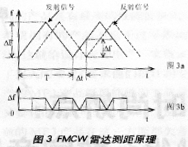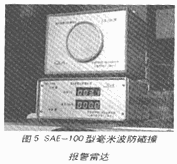Automobile anti-collision system is very important to improve the safety of driving, and the research of this system has been paid more and more attention. Since 1971, there have been many types of active car anti-collision systems, such as ultrasonic, laser, infrared, microwave, etc., but the above systems have some shortcomings, and have not been widely promoted and applied in automobiles. With the rapid development of highway networks in various countries, malignant traffic accidents continue to increase. In order to reduce accidents, protective measures such as driving belts and airbags have been adopted. However, these technologies are passive protection and cannot solve the problem fundamentally. The millimeter wave refers to an electromagnetic wave with a wavelength between 1 and 10 mm, and its RF bandwidth is large.  The high resolution and small size of the antenna components can adapt to harsh environments. Therefore, the millimeter wave radar system has the characteristics of light weight, small size and all-weather. The "active car millimeter wave anti-collision radar system" has become a hot spot in international research and development in recent years. And the existing products have begun to enter the market, and the prospects are very promising.
The high resolution and small size of the antenna components can adapt to harsh environments. Therefore, the millimeter wave radar system has the characteristics of light weight, small size and all-weather. The "active car millimeter wave anti-collision radar system" has become a hot spot in international research and development in recent years. And the existing products have begun to enter the market, and the prospects are very promising.
This article refers to the address: http://
This paper introduces the principle of active car anti-collision millimeter wave radar, and reports on the SAE-100 millimeter wave anti-collision radar prototype developed by us.
Principle of automobile anti-collision millimeter wave radar system
Active car anti-collision is based on radar ranging and speed measurement. The anti-collision radar system monitors the front of the vehicle in real time. When there is a dangerous target (such as a vehicle that stops ahead or slows down), the radar system sends an alarm to the driver in advance, so that the driver can respond in time, and the radar output signal reaches the vehicle control system. Automatic braking or deceleration depending on the situation.
The millimeter wave anti-collision radar system has two types of frequency modulated continuous wave (FMCW) radar and pulse radar. For pulse radar systems, when the target distance is very close, the time difference between the transmitted pulse and the received pulse is very small, which requires the system to adopt high-speed signal processing technology, and the close-range pulse radar system becomes very complicated and the cost increases. Therefore, the automobile millimeter wave radar collision avoidance system often adopts a frequency modulation continuous wave radar system with simple structure and low cost and suitable for short-range detection.
Millimeter wave FMCW radar system structure
The FMCW automotive radar system is shown in Figure 1, and includes an antenna, a transceiver module, a signal processing module, and an alarm module or an automobile brake device.  The RF transceiver front end is the core component of the radar system. A lot of in-depth research has been carried out on the front end at home and abroad, and great progress has been made. Front ends of various structures have been developed, including the front end of the waveguide structure, the front end of the microstrip structure, and the monolithic integration of the front end. The RF front end developed in China is mainly the front end of the waveguide structure. A typical RF front-end consists mainly of a linear VCO, a circulator, and a balanced mixer, as shown in Figure 2. The intermediate frequency signal of the front-end mixing output is sent to the data processing part of the subsequent stage through the intermediate frequency amplification. The basic goal of the data processing part is to eliminate unnecessary signals (such as clutter) and interference signals, and to process the mixed frequency signals that have been amplified by the intermediate frequency, and extract information such as the target distance and speed from the signal spectrum.
The RF transceiver front end is the core component of the radar system. A lot of in-depth research has been carried out on the front end at home and abroad, and great progress has been made. Front ends of various structures have been developed, including the front end of the waveguide structure, the front end of the microstrip structure, and the monolithic integration of the front end. The RF front end developed in China is mainly the front end of the waveguide structure. A typical RF front-end consists mainly of a linear VCO, a circulator, and a balanced mixer, as shown in Figure 2. The intermediate frequency signal of the front-end mixing output is sent to the data processing part of the subsequent stage through the intermediate frequency amplification. The basic goal of the data processing part is to eliminate unnecessary signals (such as clutter) and interference signals, and to process the mixed frequency signals that have been amplified by the intermediate frequency, and extract information such as the target distance and speed from the signal spectrum.
Millimeter wave FMCW radar ranging, speed measurement principle
The radar system transmits a series of continuously frequency-modulated millimeter waves through the antenna and receives the reflected signal of the target. The frequency of the transmitted wave changes with the law of the modulation voltage over time. Generally, the modulated signal is a triangular wave signal, and the frequency change of the transmitted signal and the received signal is as shown in Fig. 3a. The reflected wave has the same shape as the transmitted wave, but there is a delay in time (t, (the relationship between t and the target distance R can be expressed as
â–³t=2R/c (1)
Where c: speed of light  The frequency difference between the transmitted signal and the reflected signal at a certain moment is the frequency of the intermediate frequency signal of the mixed output (f (Fig. 3b). According to the triangular relationship, the target distance R can be obtained from Fig. 3a.
The frequency difference between the transmitted signal and the reflected signal at a certain moment is the frequency of the intermediate frequency signal of the mixed output (f (Fig. 3b). According to the triangular relationship, the target distance R can be obtained from Fig. 3a.
R=(cT/4â–³F)â–³f (2)
That is, the target distance is proportional to the IF frequency of the front end output.
If the reflected signal is from a relatively moving target, the reflected signal includes a Doppler shift fd caused by the relative motion of the target (see Figure 4). The output intermediate frequency at the rising and falling edges of the triangular wave can be expressed as
Fb+=â–³f-fd (3)
Fb-=â–³f+fd (4)
Where - (f: IF frequency when the target is relatively stationary; fd: Doppler shift, the sign of which is related to the direction of relative motion of the target.
According to the Doppler principle, the relative motion velocity v of the target is
v=c/4f0(fb--fb+)  =λ(fb--fb+) (5)
=λ(fb--fb+) (5)
Where - f0: the center frequency of the transmitted wave;: the wavelength of the transmitted wave.
The sign of the velocity v is related to the direction of relative movement of the target. When the target is close, v is a positive value, and v is negative. The frequency of the intermediate frequency signal of the rising and falling edges of the triangular wave is obtained by FFT transformation by the DSP.
From the formulas (2) and (5), the target distance and the relative motion speed of the target can be calculated.
Development of SAE-100 Millimeter Wave Anti-collision Radar System
After nearly a year of research, Shanghai Automotive Electronics Engineering Center has developed a prototype of the SAE-100 millimeter wave anti-collision radar system. The prototype adopts the homodyne FMCW system. The system structure is shown in Figure 1. The operating frequency is 35GHz and the ranging range is >100m.  The speed range is >100km/h. The system uses a small horn antenna with a gain of 26dB, a waveguide structure front end with a transmit power of 40mW, and advanced DSP data processing technology. The upper part includes the antenna, front end and intermediate frequency amplification module. The size is 19cm (15cm (16cm, the output signal is the amplified intermediate frequency signal. The following part is the data processing and display alarm module, which can display the target distance and relative motion speed. When the target When the distance is less than 100m, three different tones can be used to alarm according to the distance.
The speed range is >100km/h. The system uses a small horn antenna with a gain of 26dB, a waveguide structure front end with a transmit power of 40mW, and advanced DSP data processing technology. The upper part includes the antenna, front end and intermediate frequency amplification module. The size is 19cm (15cm (16cm, the output signal is the amplified intermediate frequency signal. The following part is the data processing and display alarm module, which can display the target distance and relative motion speed. When the target When the distance is less than 100m, three different tones can be used to alarm according to the distance.
A Power Cable is an assembly of one or more electrical conductors, usually held together with an overall sheath. The assembly is used for transmission of electrical power. Power cables may be installed as permanent wiring within buildings, buried in the ground, run overhead, or exposed.
Early telegraph systems used the first forms of electrical cabling, transmitting tiny amounts of power. Gutta-percha insulation used on the first submarine cables was, however, unsuitable for building wiring use since it deteriorated rapidly when exposed to air.
Modern power cables come in a variety of sizes, materials, and types, each particularly adapted to its uses.[6] Large single insulated conductors are also sometimes called power cables in the industry.
Some power cables for outdoor overhead use may have no overall sheath. Other cables may have a plastic or metal sheath enclosing all the conductors. The materials for the sheath will be selected for resistance to water, oil, sunlight, underground conditions, chemical vapors, impact, or high temperatures. In nuclear industry applications the cable may have special requirements for ionizing radiation resistance. Cable materials may be specified not to produce large amounts of smoke if burned. Cables intended for underground use or direct burial in earth will have heavy plastic or metal, most often lead sheaths, or may require special direct-buried construction. When cables must run where exposed to mechanical impact damage, they may protected with flexible steel tape or wire armor, which may also be covered by a water resistant jacket.
Armoured Power Cable, Steel Wire Armoured Cable, Armoured Wire Cable
Hebei Huanya Cable Co.,Ltd , http://www.hbhycable.com